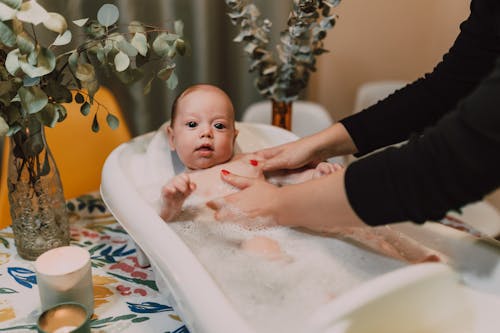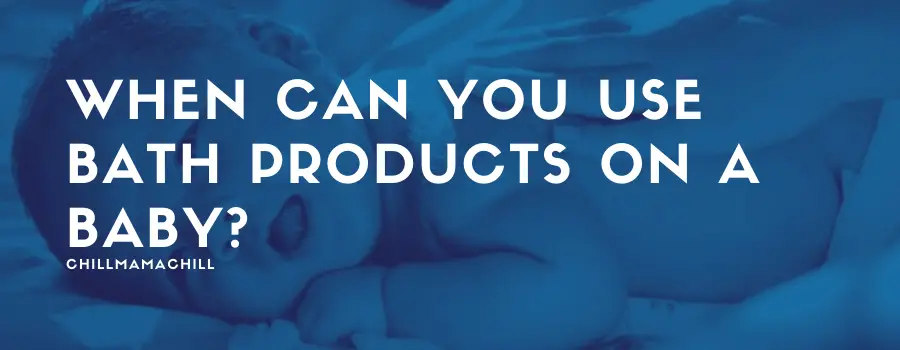It’s only natural to feel apprehension when you’ve never bathed a newborn before. While it can be a nerve-wracking experience, most babies love baths, and it’s an excellent time to bond. So, when can you use bath products on a baby?
For a newborn baby, only use plain water if it’s their first bath time. After about four to six weeks, start using non-perfumed infant soap due to their delicate skin. You can use a mild shampoo if your baby’s hair is long, lathering lightly, and rinsing off immediately.
Your newborn doesn’t need a daily bath as once or twice a week will suffice. Instead, you can top and tail, which means washing only their face, neck, hands, and bottom. You’ll also need proper preparation, putting all the tools together before getting started. Continue reading to find out when and how you use bath products on a baby.
Can I Wash My Newborn Baby in Water Using Bath Products?
Oftentimes, you’ll receive detailed instructions from your midwife on washing your newborn baby before leaving the hospital. But as these demonstrations are theoretical, nothing prepares you for your baby’s first bath. You don’t want to make a mistake, and yet you want to accomplish a clean job. All this without upsetting your child or hurting them.

Many of the questions going around your mind include what to use. That’s not made easy by the plethora of commercially available baby bath products all claiming to be the best for your baby’s bath. But what items should you or shouldn’t you use when bathing your child?
Seeing as your newborn’s skin is at its most delicate, you need to take care to maintain its texture and the overall health of your baby. At first, you’ll avoid bath products like soap or shampoo until four to six weeks later, when you’ll use the mildest cleansers and some after-bath lotion.
For your newborn’s first baths, use only warm water, washing between the folds of skin, around the neck, wrists, and thighs. Use a soft baby bath cloth or sponge to clean around the umbilical cord stump or site of circumcision. These heal after about 10 to 15 days but might take longer and could be emanating a putrid smell.
When Can I Use Bath Products on My Baby?
Until the umbilical stump falls off in a week or two, the American Academy of Pediatrics recommends sponge baths for your baby. If your tot was circumcised, only put your child in water once it’s healed. Clarify with your pediatrician as some physicists claim immersion bathing has no negative impact.
If these areas aren’t putrid or discharging, go ahead and immerse your baby in water up to their stomach without risking infection. If they’re still healing, sponge bath your tot at least one to two times a week, not daily. Take care not to upset the cord stub or circumcision wound when bathing.
Too much bathing can also dry out your child’s skin. Plus, you’ve maintained cleanliness by wiping their mouth, face, and nose after feeding alongside the frequent diaper changes or bottom wipes.
However, before bathing your tot, get bath things ready and prepare a warm flat surface like changing table, kitchen counter, firm bed, or changing table. You can even use the floor with a towel or blanket for your child to lie on.
Ensure that the room you select is warmer than room temperature, closing windows and doors to eliminate any draft. You’ll need cotton wool balls, a hooded towel, a change of clothes, and a fresh diaper. A shallow plastic basin or sink will hold warm water, which you should check with your elbow to ensure it’s not too hot.
Which Bath Products Can I Use on My Baby?
You can bath your baby at any time of day, although most mums prefer the evening as part of the bedding down ritual. Since baths are soothing and relaxing for your tot, this works well to put them to sleep. Others opt for a morning bath time when their babies are alert and in an upbeat mood. It’s best to select the time when there are few interruptions or becoming rushed.

If you’ve chosen to bathe your baby after feeding, ensure their tummy has settled first. You’ll be able to tell when it happens as your child will burp and possibly puke out remnants of their meal. Only when the four to six weeks have elapsed, and the umbilical cord or circumcision wounds have healed can you start using mild baby soaps and cleansers.
You can use bath products that are;
- Dye and fragrance-free which are chemicals that irritate your baby’s respiration and skin.
- Natural skincare products, unless there’s a history of asthma or allergies in your family. In such cases, your baby could be sensitive to the herbs and botanicals in some items.
- Paraben and phthalate-free. These are also chemicals with potentially harmful effects on your baby.
If you chose to use a talcum or corn starch powder, use it carefully, spreading it into your hand before applying it to your child’s skin. Keep it away from your baby’s face and genitalia, and don’t shake it in the air as it releases talc dust. While the protection provided is minimal, some powders can be abrasive or cause breathing difficulties.
Can I Use Lotion or Shampoo on My Baby?
If you don’t use harsh soaps during bath time, your newborn baby won’t need lotion after a bath. A small dab of moisturizer is all you need if your child’s skin is dry, massaging it in the affected areas. While this makes your tot feel great, persistent dryness could mean you’re bathing too often.
When you think your baby’s hair needs washing, use your free hand while holding the head to apply a drop of mild baby shampoo. Scrub your child’s scalp gently and then rinse off with a cup of warm water, or use a damp washcloth. Cup one hand on your tot’s forehead while rinsing so that suds don’t go into their eyes.
Always make sure water is warm at best to prevent scalding your child. Set the kettle, heater, or boiler thermostat to below 100° Fahrenheit. Always check the temperature with the outside of your elbow before dipping or bathing your child. The room should also be comfortably warm to prevent chilling and use a hooded towel to dry and swaddle your baby immediately.
Conclusion
Use mild soap sparingly as too much dries your tot’s skin. Avoid relying too much on product advertising labeling, but instead read the ingredients carefully, researching the ones you’re unfamiliar with. When your tot is dealing with diaper rash, eczema, or dry skin, introduce baby powder, moisturizing lotion, or petroleum jelly.

I’m Cathrine and I’m a 39-year-old mother of 3 from Utica, New York. And I’m extremely happy you’ve come to visit my hide-out on the web. Here I post about everything related to family-life and usually it will involve babies and lessons I’ve learned over the years from experts, friends, and my own mistakes. So hopefully you will find what i write fun and informational!

